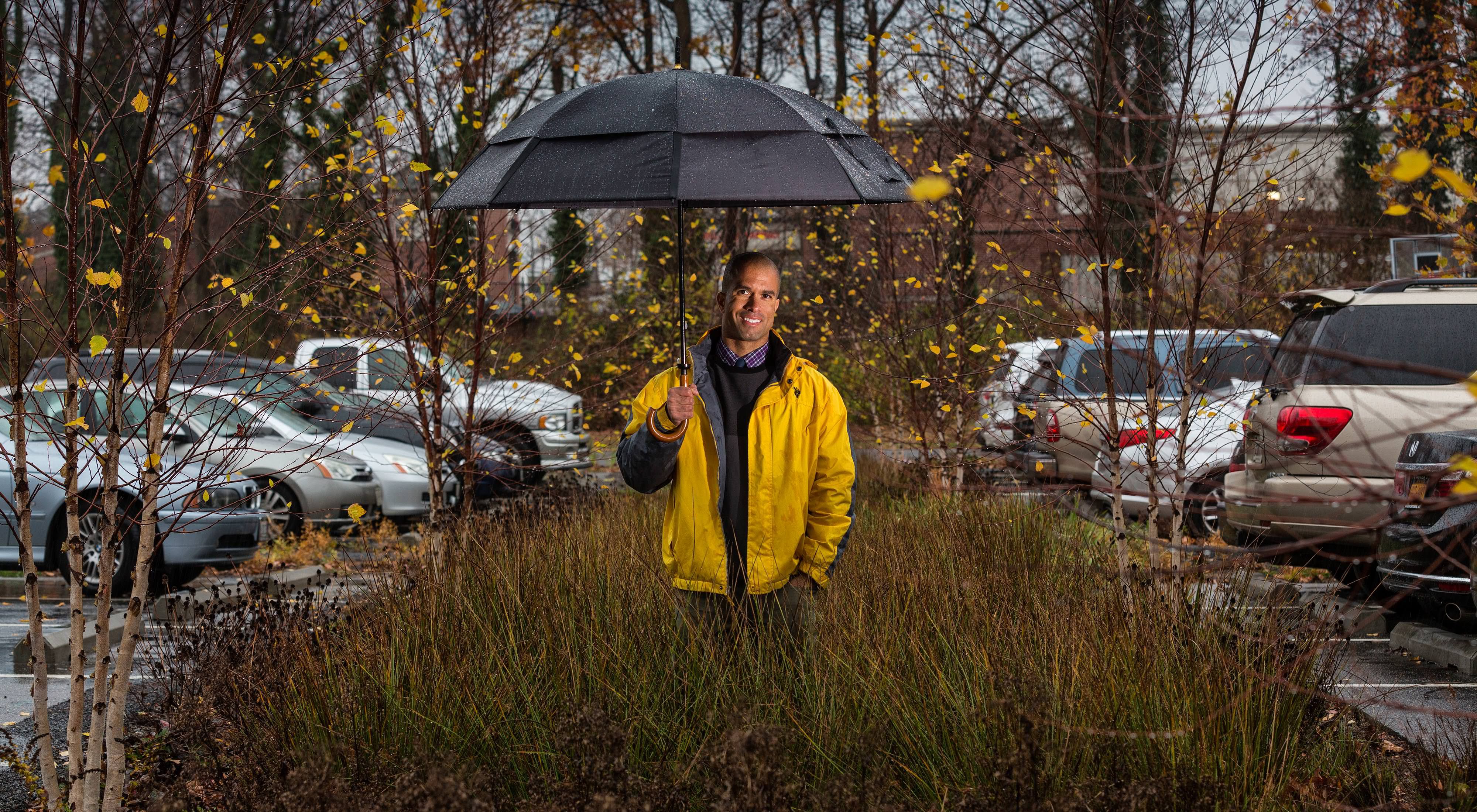Interview: Kahlil Kettering
The Nature Conservancy’s director of urban conservation in Maryland and Washington, D.C., talks about keeping city stormwater out of rivers.
Summer 2017
Trash cleanup days along the Anacostia River have become pretty routine in Washington, D.C., over the past decade. Less routine is having infants out there “participating” in the volunteer event, as was the case with your niece a while back. You told her mother, who was reluctant to bring her, that your niece was never too young to see it. See what?
The Styrofoam, the trash. But also the calm, the wild space, just a few miles from the nation’s Capitol.
When you were her age, you too lived in D.C. So you’ve seen the Anacostia—the Potomac River’s lesser-known cousin, polluted by a nearby federal Superfund site—as it has changed over the years. What makes you optimistic about the river’s future now?
It’s come a long way. I remember going out on it when it was a dirty, dangerous place—with appliances and cars and tires in the water. Now the river is starting to look healthier and cleaner. When you go down there, you can see bald eagles flying and osprey fishing and tons of turtles. And you see people kayaking and boating. People are starting to love the river again.
That’s in part because of a D.C. tax on plastic bags that has provided funding for cleanup efforts. But the water is still highly contaminated, right?
Yes. D.C. has a lot of development and the city has a major challenge with stormwater: In a single 24 hours, a storm producing 1.2 inches of rain results in 525 million gallons of water pouring into storm drains and ending up in the Anacostia, the Potomac and eventually the Chesapeake Bay—one of the most productive estuaries in North America.
We’re talking about rainwater in storm drains though, not raw sewage. So what’s the problem?
That water is running off the pavement, picking up gas, oil and other chemicals from cars and going right into the rivers with no treatment. The runoff is also picking up heat and velocity, which causes erosion and sedimentation in the river.
Washington has some fairly new regulations in place to clean up stormwater before it hits the rivers. The city is requiring owners of new buildings to retain most of their stormwater—through green roofs, cisterns, rain gardens and the like. But what if a building can’t absorb all of its own stormwater?
The city has created a database, a virtual marketplace, that lists stormwater retention credits for sale. Owners can go to the marketplace to buy credits. One gallon of saved stormwater equals one credit.
So for every gallon the new building doesn’t absorb, the owner can pay for water to be absorbed elsewhere. It’s essentially a credit market. Where does The Nature Conservancy come in?
On the supply side. We find owners of large properties that are not subject to the new rule because they’re not new developments. For instance a church parking lot generates a whole lot of runoff. We can get a design for stormwater retention, like a rain garden, have it installed and certified, and then put those credits on the marketplace.
And that also would put money back in the church’s pockets because it wouldn’t have to pay fees for excessive runoff anymore. At the moment, though, there aren’t a lot of credits for sale on the marketplace.
That’s why TNC is bringing private equity into the equation. In March 2016, Prudential invested $1.7 million in District Stormwater LLC, a partnership between TNC and Encourage Capital that pays for, develops and manages projects that generate stormwater retention credits.
Does District Stormwater have any projects underway in the city?
Mount Olivet, a Catholic cemetery. It’s on a hill just west of the Anacostia. The cemetery is paying a very high fee for its stormwater runoff right now, but a retention project is too expensive for the cemetery to do on its own. This is our proof-of-concept project.
What do you mean?
We want to show how the stormwater credit market works and bring in more players to create more retention. We want to create big blocks of credit.
Proving that private-equity projects work would open the possibility of a vast pool of Wall Street investment—as much as $1 billion for conservation projects, I’ve heard. What kind of interest has there been?
We’re getting calls from lots of cities, such as Chicago and St. Louis. They see the credit market as a way to help meet requirements mandated by the Environmental Protection Agency and to do it without using city funds. But these cities aren’t going to do it until they see if it works. That’s why we’re involved. The Conservancy has the ability to create things on a large scale and to take the lessons learned and replicate them.
In the process, you’re also cleaning up a neglected neighborhood river for future generations, like your niece’s.
Yeah. She’s a motivation and a reminder. This is part of why we do this. This is her inheritance. I’m helping to protect and preserve the future for her.
